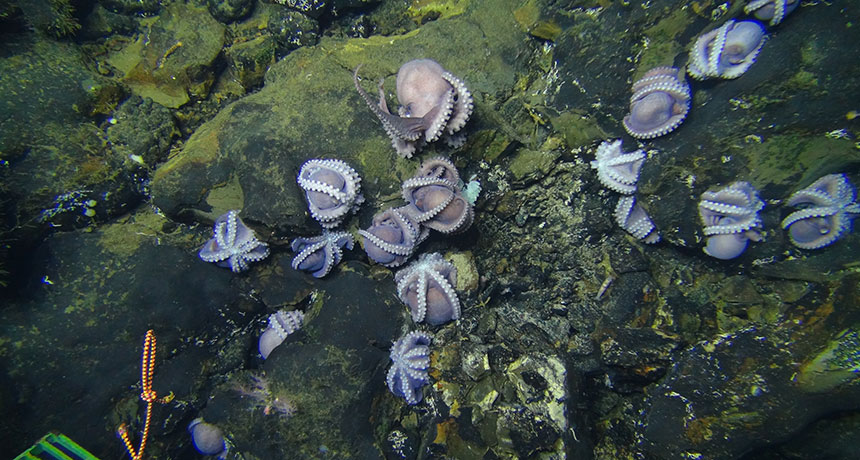Deep-sea expedition led researchers to doomed octopus nursery
The good news: A healthy population of octopods may be nearby

Sixteen out of these 17 deep-sea octopuses are brooding young. However, young and old, all are fated to die.
Phill Torres, Geoff Wheat
A geology voyage to study the fluid coming from a rocky outcrop deep below the ocean’s surface turned up something unexpected. It was a population of purple octopuses brooding their young. The colony is probably doomed due to the warm flow of low-oxygen water coming out of the rock. However, those ill-fated animals may be an indicator that healthy kin are hiding out nearby. That’s the conclusion of a new study.
The octopuses reside at a site 3,000 meters (1.8 miles) deep called Dorado Outcrop. It’s some 250 kilometers (155 miles) off the coast of the Central American country of Costa Rica. The outcrop is essentially a buried, 23-million-year-old mountain.
“Fluid is discharging from this outcrop because at some other location there’s fluid flowing from the bottom of the ocean into the earth,” notes Anne Hartwell. She’s a marine research scientist with the University of Alaska Fairbanks. Just where that fluid is entering isn’t known. What path that the water takes through the earth is also a mystery.
But geoscientists were curious about emerging fluid. That’s why they visited the site in 2013. They sent a remote-controlled research vehicle called Jason II to take images. Those images revealed a wealth of brooding octopuses clinging onto the side of the outcrop. “Everyone thought they were cool, but no one really did anything about it,” Hartwell says. “There were biologists on board,” she adds. “But they were microbiologists.” (Microbiologists study small organisms, such as bacteria.)
Hartwell wasn’t on that trip. But she was on another one a year later that visited the site in the research submarine ALVIN. “When I got to the seafloor … there was so much life,” she recalls. The octopuses weren’t even the highlight for her. “I saw sea sponges and sea stars and crabs and shrimp. And they were colorful,” she adds. “I hadn’t expected that type of macrofauna — big organisms — that deep,” she says. “And then the octopuses were there. And it was just, ‘Whoa, this place is cool!’”
Those octopuses intrigued Hartwell. She teamed up with Geoffrey Wheat of the University of Alaska Fairbanks. He was a geoscientist from the original cruise. Janet Voight of the Field Museum in Chicago, Ill., is a cephalopod expert. She completed the trio. The team examined hours of video, still images and other data that had been collected on the two deep-sea missions.
The octopuses belonged to a not-well-known genus of deep-sea octopods known as Muusoctopus. Hundreds of them were seen during the two expeditions. Many had cemented themselves to the outcrop. Some appeared to be brooding eggs.
Those octopuses had attached themselves in an area where the fluid flowed out of the rocks only occasionally. That fluid is 10 degrees Celsius (18 degrees Fahrenheit) warmer than the surrounding water, which is a constant, and chilly, 2 °C (36 °F). The discharge also contains less oxygen than the surrounding water.
“I had initially assumed that … [the octopuses] really wanted to be there,” says Hartwell. It wasn’t until she took a closer look at the evidence and consulted with Voight that it became clear these animals are probably stressed by the fluid. The moms may have settled there when no fluid was flowing and then were stuck after the conditions had changed. The species should be well adapted to the cold, higher-oxygen conditions found in the deep ocean. When they find themselves out of their normal element, the octopuses — including their young — probably don’t survive.
The team reports this in the May issue of Deep Sea Research I.
But it’s not all bad news. Hartwell and her colleagues think that the doomed cephalopods are an indicator that a larger population exists nearby. In some cases, there were just arms or part of a mantle sticking out of the rock. “That was our evidence that there were octopuses that could fit inside spaces available on this outcrop,” Hartwell says. “These spaces are notably not associated with any fluid discharge.”
Hartwell is reluctant, though, to say that such a population really exists. “Because we can’t see it,” she cautions, “we have no way of knowing whether they’re there or not.” She hopes that scientists might be able to revisit the outcrop, one day, and poke around in search of those hidden octopuses. For now, she’s working to classify the rest of that colorful community that so dazzled her deep beneath the ocean surface.







